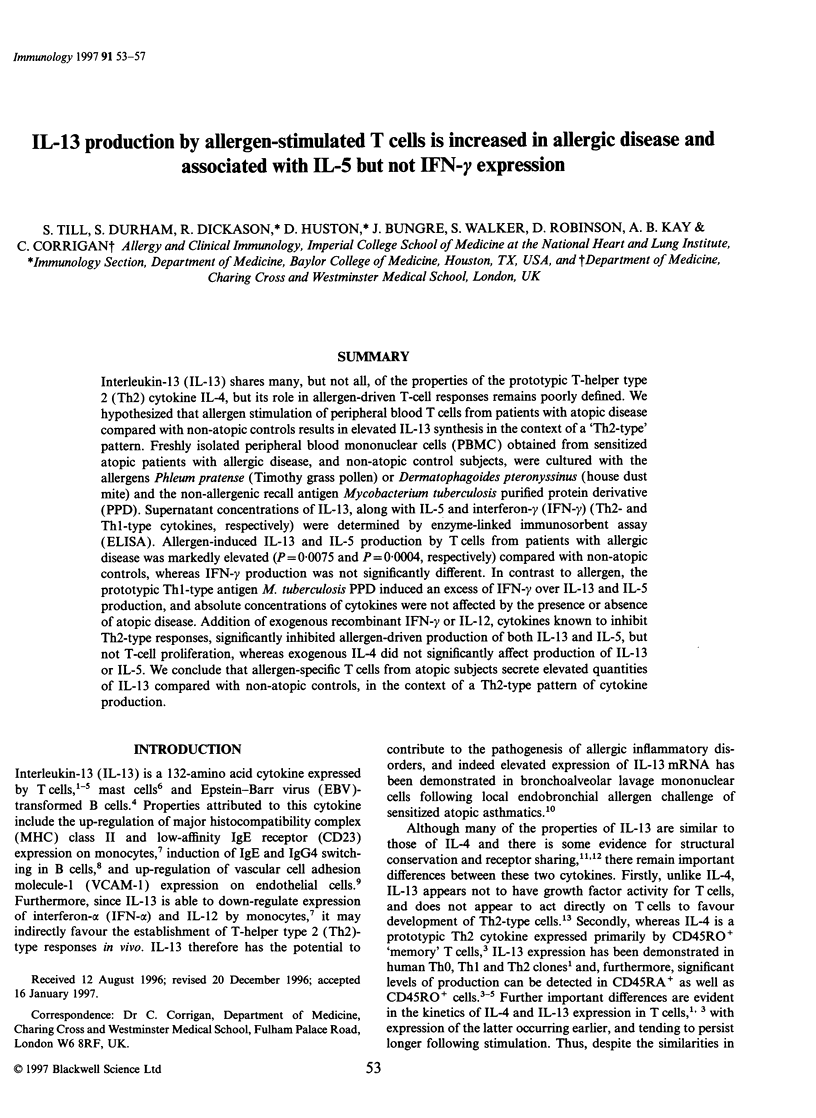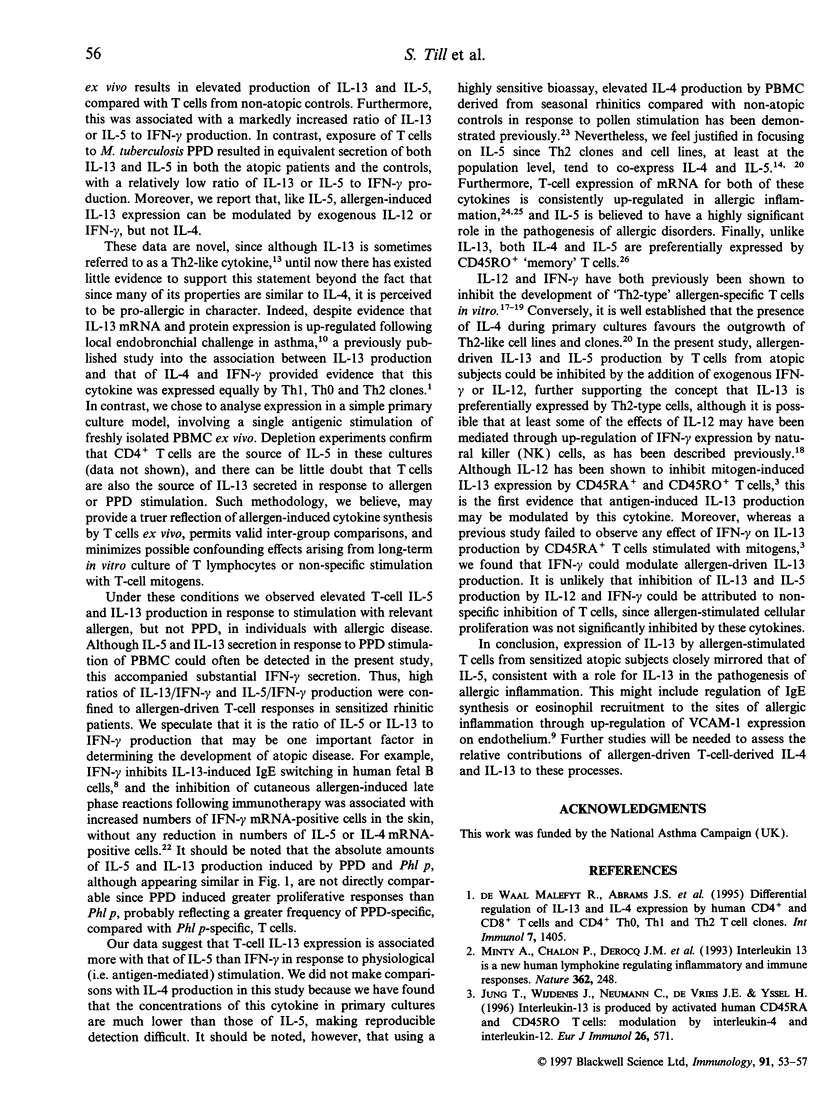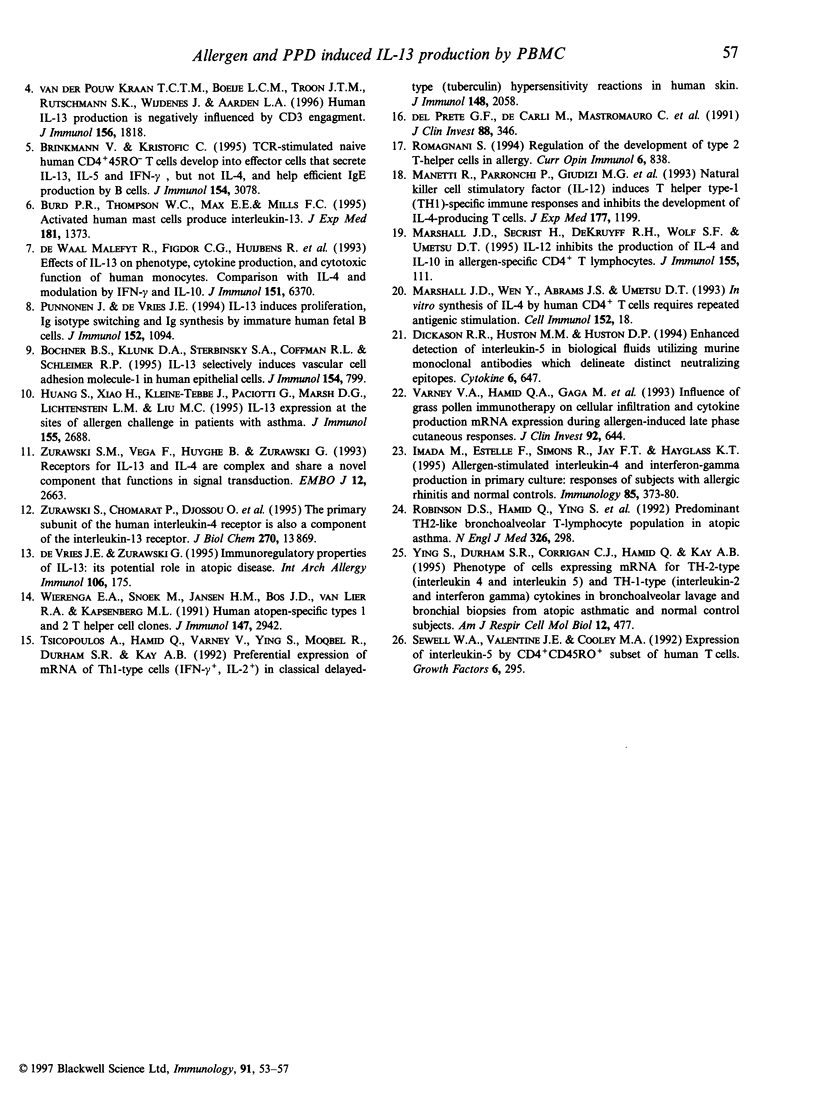Abstract
Interleukin-13 (IL-13) shares many, but not all, of the properties of the prototypic T-helper type 2 (Th2) cytokine IL-4, but its role in allergen-driven T-cell responses remains poorly defined. We hypothesized that allergen stimulation of peripheral blood T cells from patients with atopic disease compared with non-atopic controls results in elevated IL-13 synthesis in the context of a 'Th2-type' pattern. Freshly isolated peripheral blood mononuclear cells (PBMC) obtained from sensitized atopic patients with allergic disease, and non-atopic control subjects, were cultured with the allergens Phleum pratense (Timothy grass pollen) or Dermatophagoides pteronyssinus (house dust mite) and the non-allergenic recall antigen Mycobacterium tuberculosis purified protein derivative (PPD). Supernatant concentrations of IL-13, along with IL-5 and interferon-gamma (IFN-gamma) (Th2- and Th1-type cytokines, respectively) were determined by enzyme-linked immunosorbent assay (ELISA). Allergen-induced IL-13 and IL-5 production by T cells from patients with allergic disease was markedly elevated (P = 0.0075 and P = 0.0004, respectively) compared with non-atopic controls, whereas IFN-gamma production was not significantly different. In contrast to allergen, the prototypic Th1-type antigen M. tuberculosis PPD induced an excess of IFN-gamma over IL-13 and IL-5 production, and absolute concentrations of cytokines were not affected by the presence or absence of atopic disease. Addition of exogenous recombinant IFN-gamma or IL-12, cytokines known to inhibit Th2-type responses, significantly inhibited allergen-driven production of both IL-13 and IL-5, but not T-cell proliferation, whereas exogenous IL-4 did not significantly affect production of IL-13 or IL-5. We conclude that allergen-specific T cells from atopic subjects secrete elevated quantities of IL-13 compared with non-atopic controls, in the context of a Th2-type pattern of cytokine production.
Full text
PDF




Selected References
These references are in PubMed. This may not be the complete list of references from this article.
- Bochner B. S., Klunk D. A., Sterbinsky S. A., Coffman R. L., Schleimer R. P. IL-13 selectively induces vascular cell adhesion molecule-1 expression in human endothelial cells. J Immunol. 1995 Jan 15;154(2):799–803. [PubMed] [Google Scholar]
- Brinkmann V., Kristofic C. TCR-stimulated naive human CD4+ 45RO- T cells develop into effector cells that secrete IL-13, IL-5, and IFN-gamma, but no IL-4, and help efficient IgE production by B cells. J Immunol. 1995 Apr 1;154(7):3078–3087. [PubMed] [Google Scholar]
- Burd P. R., Thompson W. C., Max E. E., Mills F. C. Activated mast cells produce interleukin 13. J Exp Med. 1995 Apr 1;181(4):1373–1380. doi: 10.1084/jem.181.4.1373. [DOI] [PMC free article] [PubMed] [Google Scholar]
- Del Prete G. F., De Carli M., Mastromauro C., Biagiotti R., Macchia D., Falagiani P., Ricci M., Romagnani S. Purified protein derivative of Mycobacterium tuberculosis and excretory-secretory antigen(s) of Toxocara canis expand in vitro human T cells with stable and opposite (type 1 T helper or type 2 T helper) profile of cytokine production. J Clin Invest. 1991 Jul;88(1):346–350. doi: 10.1172/JCI115300. [DOI] [PMC free article] [PubMed] [Google Scholar]
- Dickason R. R., Huston M. M., Huston D. P. Enhanced detection of human IL-5 in biological fluids utilizing murine monoclonal antibodies which delineate distinct neutralizing epitopes. Cytokine. 1994 Nov;6(6):647–656. doi: 10.1016/1043-4666(94)90053-1. [DOI] [PubMed] [Google Scholar]
- Huang S. K., Xiao H. Q., Kleine-Tebbe J., Paciotti G., Marsh D. G., Lichtenstein L. M., Liu M. C. IL-13 expression at the sites of allergen challenge in patients with asthma. J Immunol. 1995 Sep 1;155(5):2688–2694. [PubMed] [Google Scholar]
- Imada M., Simons F. E., Jay F. T., Hayglass K. T. Allergen-stimulated interleukin-4 and interferon-gamma production in primary culture: responses of subjects with allergic rhinitis and normal controls. Immunology. 1995 Jul;85(3):373–380. [PMC free article] [PubMed] [Google Scholar]
- Jung T., Wijdenes J., Neumann C., de Vries J. E., Yssel H. Interleukin-13 is produced by activated human CD45RA+ and CD45RO+ T cells: modulation by interleukin-4 and interleukin-12. Eur J Immunol. 1996 Mar;26(3):571–577. doi: 10.1002/eji.1830260311. [DOI] [PubMed] [Google Scholar]
- Manetti R., Parronchi P., Giudizi M. G., Piccinni M. P., Maggi E., Trinchieri G., Romagnani S. Natural killer cell stimulatory factor (interleukin 12 [IL-12]) induces T helper type 1 (Th1)-specific immune responses and inhibits the development of IL-4-producing Th cells. J Exp Med. 1993 Apr 1;177(4):1199–1204. doi: 10.1084/jem.177.4.1199. [DOI] [PMC free article] [PubMed] [Google Scholar]
- Marshall J. D., Secrist H., DeKruyff R. H., Wolf S. F., Umetsu D. T. IL-12 inhibits the production of IL-4 and IL-10 in allergen-specific human CD4+ T lymphocytes. J Immunol. 1995 Jul 1;155(1):111–117. [PubMed] [Google Scholar]
- Minty A., Chalon P., Derocq J. M., Dumont X., Guillemot J. C., Kaghad M., Labit C., Leplatois P., Liauzun P., Miloux B. Interleukin-13 is a new human lymphokine regulating inflammatory and immune responses. Nature. 1993 Mar 18;362(6417):248–250. doi: 10.1038/362248a0. [DOI] [PubMed] [Google Scholar]
- Punnonen J., de Vries J. E. IL-13 induces proliferation, Ig isotype switching, and Ig synthesis by immature human fetal B cells. J Immunol. 1994 Feb 1;152(3):1094–1102. [PubMed] [Google Scholar]
- Robinson D. S., Hamid Q., Ying S., Tsicopoulos A., Barkans J., Bentley A. M., Corrigan C., Durham S. R., Kay A. B. Predominant TH2-like bronchoalveolar T-lymphocyte population in atopic asthma. N Engl J Med. 1992 Jan 30;326(5):298–304. doi: 10.1056/NEJM199201303260504. [DOI] [PubMed] [Google Scholar]
- Romagnani S. Regulation of the development of type 2 T-helper cells in allergy. Curr Opin Immunol. 1994 Dec;6(6):838–846. doi: 10.1016/0952-7915(94)90002-7. [DOI] [PubMed] [Google Scholar]
- Sewell W. A., Valentine J. E., Cooley M. A. Expression of interleukin 5 by the CD4+CD45R0+ subset of human T cells. Growth Factors. 1992;6(4):295–302. doi: 10.3109/08977199209021541. [DOI] [PubMed] [Google Scholar]
- Tsicopoulos A., Hamid Q., Varney V., Ying S., Moqbel R., Durham S. R., Kay A. B. Preferential messenger RNA expression of Th1-type cells (IFN-gamma+, IL-2+) in classical delayed-type (tuberculin) hypersensitivity reactions in human skin. J Immunol. 1992 Apr 1;148(7):2058–2061. [PubMed] [Google Scholar]
- Varney V. A., Hamid Q. A., Gaga M., Ying S., Jacobson M., Frew A. J., Kay A. B., Durham S. R. Influence of grass pollen immunotherapy on cellular infiltration and cytokine mRNA expression during allergen-induced late-phase cutaneous responses. J Clin Invest. 1993 Aug;92(2):644–651. doi: 10.1172/JCI116633. [DOI] [PMC free article] [PubMed] [Google Scholar]
- Wierenga E. A., Snoek M., Jansen H. M., Bos J. D., van Lier R. A., Kapsenberg M. L. Human atopen-specific types 1 and 2 T helper cell clones. J Immunol. 1991 Nov 1;147(9):2942–2949. [PubMed] [Google Scholar]
- Ying S., Durham S. R., Corrigan C. J., Hamid Q., Kay A. B. Phenotype of cells expressing mRNA for TH2-type (interleukin 4 and interleukin 5) and TH1-type (interleukin 2 and interferon gamma) cytokines in bronchoalveolar lavage and bronchial biopsies from atopic asthmatic and normal control subjects. Am J Respir Cell Mol Biol. 1995 May;12(5):477–487. doi: 10.1165/ajrcmb.12.5.7742012. [DOI] [PubMed] [Google Scholar]
- Zurawski S. M., Vega F., Jr, Huyghe B., Zurawski G. Receptors for interleukin-13 and interleukin-4 are complex and share a novel component that functions in signal transduction. EMBO J. 1993 Jul;12(7):2663–2670. doi: 10.1002/j.1460-2075.1993.tb05927.x. [DOI] [PMC free article] [PubMed] [Google Scholar]
- de Vries J. E., Zurawski G. Immunoregulatory properties of IL-13: its potential role in atopic disease. Int Arch Allergy Immunol. 1995 Mar;106(3):175–179. doi: 10.1159/000236842. [DOI] [PubMed] [Google Scholar]
- de Waal Malefyt R., Abrams J. S., Zurawski S. M., Lecron J. C., Mohan-Peterson S., Sanjanwala B., Bennett B., Silver J., de Vries J. E., Yssel H. Differential regulation of IL-13 and IL-4 production by human CD8+ and CD4+ Th0, Th1 and Th2 T cell clones and EBV-transformed B cells. Int Immunol. 1995 Sep;7(9):1405–1416. doi: 10.1093/intimm/7.9.1405. [DOI] [PubMed] [Google Scholar]
- de Waal Malefyt R., Figdor C. G., Huijbens R., Mohan-Peterson S., Bennett B., Culpepper J., Dang W., Zurawski G., de Vries J. E. Effects of IL-13 on phenotype, cytokine production, and cytotoxic function of human monocytes. Comparison with IL-4 and modulation by IFN-gamma or IL-10. J Immunol. 1993 Dec 1;151(11):6370–6381. [PubMed] [Google Scholar]
- van der Pouw Kraan T. C., Boeije L. C., Troon J. T., Rutschmann S. K., Wijdenes J., Aarden L. A. Human IL-13 production is negatively influenced by CD3 engagement. Enhancement of IL-13 production by cyclosporin A. J Immunol. 1996 Mar 1;156(5):1818–1823. [PubMed] [Google Scholar]


